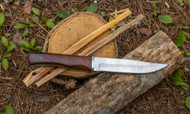Common Knife Blade Shapes and Their Uses
Apr 23 2024 - 2:20
Knives are much more than mere kitchen tools or camping essentials; they are objects of meticulous design and remarkable utility. Central to their functionality is the blade—the very essence of their purpose. For the uninitiated, knife jargon can be intimidating, making finding the right one nearly impossible. In order to help with this, we’ve put together a brief guide covering the most common knife blade shapes on the market. By talking about their differences and best practical uses, we hope to make the purchasing process much easier for fledgling knife enthusiasts.
The Drop Point Blade Shape
When talking about versatile blade design, the drop point would likely take center stage. Its unpretentious profile features a convex curve that meets a slightly dropped tip, creating a robust yet controllable edge.
This blade shape is the bedrock of utilitarian pocketknives and hunting blades for a multitude of reasons. Firstly, the broader belly and stout tip are conducive to a wide range of cutting tasks, from slicing to puncturing. Because of its lowered point, you’re less likely to accidentally pierce what you didn’t intend, making it a safer option for everyday use. However, its symmetrical design can lead to a less refined point that might not perform as well with detailed work.
The Tanto Blade Shape
Evoking the spirit of Japanese craftsmanship, the tanto blade is a statement of focused precision. Its chisel-like edge delivers strength and straight lines. Practical in structure, the cramped tip withstands heavy thrusts but sacrifices some versatility in the process.
In modern applications, you’ll find the tanto style a favorite among tactical knives, where concise angles are favored for their ability to pierce and cut through tough materials effortlessly. The trade-off here is evident—it may not be the best companion for everyday, all-purpose use unless you find yourself in need of some serious precision cutting on a regular basis.
The Clip Point Blade Shape
Balancing elegance with function, the clip point is a fan favorite. It features a concave cut along the spine and a pronounced, clipped-off tip that lends itself to fine detail and controlled cuts. This blade shape is ideal for those who need to transition effortlessly from carving to slicing without switching knives.
Hunters and cooks also appreciate the clip point’s acute point for skinning and boning. The downside? The spine’s concave shape can sometimes make the blade more acutely pointed, reducing its overall strength.
Where To Get Your Knife
Now that you have a better idea of how to use some of the more common knife blade shapes, it’s time to decide which is best for you. Here at the Knife Connection, you’ll be able to find a knife with just the blade shape you’re looking for. Be sure to check out our ESEE knives for sale, along with all the other brands we carry on our site.
